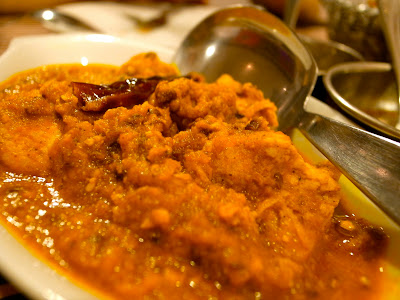Japanese food is very popular the world throughout, and Manila is no exception. In major shopping malls, there's almost always a restaurant, a food booth, or a fast food chain that has a Japanese theme to it. However, there's a little nook along Makati's Pasong Tamo that really gives a slice of authentic Japan. The place is called "Little Tokyo" and it is a collection of restaurants all surrounding a quaint little courtyard. The presence of cats along the alleyway leading to the place already reminds one of Japan :-).
Only one restaurant will be featured by the fennel bulbs for this entry, and it's the first restaurant from the alleyway. It's called Ryozen (りょぜん) and it is quite a yakiniku restaurant, a sushi-ya, and an izakaya all packed into one. The restaurant is quite cozy, but typical of a bustling Oriental eatery, the noise levels are a bit high. One can choose to eat by the counter where one can watch the cooks and the elderly Japanese chef prepare the orders neatly while watching some NHK or some Japanese soap on the TV.
Above is a plate of hiyayakko (ひややっこ, Php110) or a tofu appetizer. Soft tofu is used and the dressing has the right balance of saltiness (from the shoyu), and a hint of sweetness (which is perhaps from mirin). Bonito flakes, ginger, and spring onion is drizzled on top. A very refreshing and light appetizer, indeed.
Next is the futomaki (ふとまき, Php300). It's quite a meal in itself already. The fillings are very substantial, and compared to other futomakis served elsewhere, it is very tasty! The filling consists of rolled-up egg (玉子), some cooked onions (which may be the reason why it's so tasty), cucumber, and kani sticks. Each slice is a hefty piece so it's best to use the hands to gobble one slice up, as using chopsticks would just ruin it.
Next is a plateful of beef curry rice (~Php300). The curry tastes good and reminds one of those S&B ready-made curry formulas, but the chunks of beef used should need some more tenderizing as they are moderately tough! Nevertheless the taste made up for the failure in texture.
Lastly, but not the least is a basic yakiniku mix (~Php350). Mostly chicken innards (gizzard, liver, intestines) plus the skins and the flesh are skewered onto the barbecue sticks, with the exception of the leeks and the shiitake mushrooms. Some Japanese mustard is served on a little plate as a condiment. The quality of the innards and the manner with which they were cooked are good, and there's no staleness to the taste, which is quite common with innards.
Service is also very good and the waiters are attentive, which are typical of Japanese-owned establishments. Everyone was friendly and courteous, and one can just have a seat and chat the evening away with the elderly Japanese chef.






















